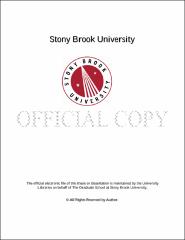| dc.identifier.uri | http://hdl.handle.net/11401/77387 | |
| dc.description.sponsorship | This work is sponsored by the Stony Brook University Graduate School in compliance with the requirements for completion of degree. | en_US |
| dc.format | Monograph | |
| dc.format.medium | Electronic Resource | en_US |
| dc.language.iso | en_US | |
| dc.publisher | The Graduate School, Stony Brook University: Stony Brook, NY. | |
| dc.type | Dissertation | |
| dcterms.abstract | Body size may have played a major role in the adaptive radiation of the Threespine Stickleback (Gasterosteus aculeatus) species complex as the basis for the assortative mating involved in maintaining divergence between marine and freshwater, benthic and limnetic, and lake and stream populations in sympatry. The trait is known to be heritable in sticklebacks and other fish species, and considerable size differences within and among populations suggest large genetic variation on which natural selection can act. This dissertation addresses fundamental questions about divergence in life history traits associated with body size in Threespine Stickleback among populations divergent for the trait on a small geographic scale (Cook Inlet drainages in Alaska, USA). Chapter 1 quantifies the degree of size divergence among populations in Cook Inlet drainages. Chapter 2 asks whether body size variation is explained by divergence in other life history traits, like age structure, average lifespan, or age and size at maturation. Chapter 3 identifies candidate growth genes under selection and associated with growth phenotypes within populations of Threespine Stickleback. I found significant divergence among populations in body size, age structure and lifespan, and size and age at maturation. Size differences among populations were substantial even after accounting for differences in age structure, and were not correlated with local environmental variables (e.g., lake size, productivity, and concentrations of important ions) or measures of geographic proximity or distance from the sea. I identified single nucleotide polymorphism (SNP) markers within three candidate growth genes associated with growth rate in a single population. SNP markers in all but two candidate growth genes were detected as loci under directional or stabilizing selection in an FST outlier analysis. Thus, I found evidence for (a) significant divergence in body size across populations of Threespine Stickleback within a small geographic region, (b) local adaptation to different life history regimes including differences in growth rate, age structure and lifespan, and age and size at maturation, and (c) a significant genetic component to potential local and convergent evolution of life histories among populations. | |
| dcterms.available | 2017-09-20T16:52:36Z | |
| dcterms.contributor | Eanes, Walter | en_US |
| dcterms.contributor | Rohlf, F. James | en_US |
| dcterms.contributor | Rest, Joshua | en_US |
| dcterms.contributor | Baumann, Hannes. | en_US |
| dcterms.creator | Rollins, Jennifer Lynn | |
| dcterms.dateAccepted | 2017-09-20T16:52:36Z | |
| dcterms.dateSubmitted | 2017-09-20T16:52:36Z | |
| dcterms.description | Department of Ecology and Evolution | en_US |
| dcterms.extent | 193 pg. | en_US |
| dcterms.format | Monograph | |
| dcterms.format | Application/PDF | en_US |
| dcterms.identifier | http://hdl.handle.net/11401/77387 | |
| dcterms.issued | 2017-05-01 | |
| dcterms.language | en_US | |
| dcterms.provenance | Made available in DSpace on 2017-09-20T16:52:36Z (GMT). No. of bitstreams: 1
Rollins_grad.sunysb_0771E_13291.pdf: 7028550 bytes, checksum: b22e52553d2199ea55df3a87f9dd415b (MD5)
Previous issue date: 1 | en |
| dcterms.publisher | The Graduate School, Stony Brook University: Stony Brook, NY. | |
| dcterms.subject | age, body size, candidate genes, growth, life history, somatotropic axis | |
| dcterms.subject | Evolution & development -- Biology | |
| dcterms.title | Size and Age-Structure Divergence and the Genetic Basis of Growth Among Populations of Threespine Stickleback (Gasterosteus aculeatus) | |
| dcterms.type | Dissertation | |

